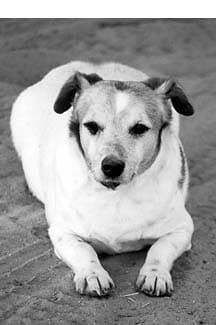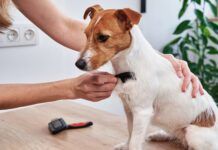The elderly man shuffled through the front door of the Humane Society, his Wirehaired Dachshund waddling close to his heels. The man’s shoulders were hunched, his wrinkled cheeks streaked with tears. His eyes refused to meet mine. He held the red nylon leash in a death-grip in his wizened hands. Gently, I asked if I could help him.
He finally looked at me as he choked out the words. “I have to give up my dog, Rags. I’m moving into the Veteran’s Home, and they don’t allow dogs there.”
I looked down at Rags. Huddled on the floor next to her human companion, she looked as miserable as he did. Much of her misery no doubt stemmed from her sensitivity to her master’s emotional pain. But some of it was clearly attributable to the fact that she was so obese that she literally could not lie down comfortably. Her belly dragged on the ground as she walked – she could have lifted all four of her legs and not settled any farther onto the floor.

I tried to be reassuring, telling the man that we would do the very best we could for Rags. At this humane society, far more than most, we were able to use our resources to rehome difficult-to-place dogs. If Rags’ obesity was due to a medical problem, I cautioned, it might be an impossible task, and unfair to ask a new owner to take on the costs of care and treatment. If it were simply a matter of overfeeding, the prognosis for her future was far more positive. Crossing my fingers and hoping for the latter, I filled out the intake forms.
Tears filled my eyes as I took Rags’ leash and watched the old man shuffle disconsolately out the door. Trapped between impossible choices, he had just given away his best friend in life. I could do nothing for the pain of his loss, but hopefully I would be able to help Rags – even though the rotund Dachsund turned out to weigh an astonishing 60 pounds! (Normal adult weight for this breed is about 16-32 pounds.) I called a veterinarian who worked closely with our shelter, and arranged for the nearly immobile little dog to be transported to her for blood tests and a thorough examination and prognosis.
Leading health problem
Obesity has been defined as a body weight 10 to 20 percent above the ideal weight for that individual dog. The rule of thumb offered by most sources is that if you sweep your fingers lightly over your dog’s ribs and shoulders you should be able to feel the outline of the bones. If you must use pressure to find the ribs, your dog is overweight. Viewed from above, your dog should have a noticeable waist. If Bowser fails either of these two tests, it’s time for doggy dieting.
Veterinarians today consider obesity to be the leading health problem among our dogs and cats. According to the U.C. Davis School of Veterinary Medicine’s Book of Dogs, this manifestation of malnutrition affects an estimated 25-44 percent of our canine companions. Just like us, dogs get fat because they get too many calories and not enough exercise. And just like us, overweight dogs are prone to serious health problems, including diabetes, heart disease, high blood pressure, constipation, heat intolerance, increased risk under anesthesia, arthritis, skin, respiratory, liver and urinary tract malfunctions.
Some breeds of dogs appear more prone to obesity than others. These include Labradors, Dachshunds, Beagles, Shelties and Basset Hounds. Spayed and neutered animals are more likely to get fat as a result of the decreased level of activity common in sterilized pets, not because of the surgery itself. Older dogs may gain weight because, just like us, their metabolism slows as they age.
Free-feeding – leaving kibble available for munching at will – is another major contributing factor to canine obesity. The bottom line for the wide-bottomed Bowser is that, barring a medical problem, his weighty woes are caused by couch-potato syndrome: munching too much and not working out enough.
Since Bowser’s owner controls the food bowl and the leash, the finger of blame must point directly at the human element of Bowser’s weight equation. Spaying and neutering, advancing age, and pre-programmed genetic packages don’t make your dog fat – too much food and not enough exercise does. The simple answer to the fat dog problem is for the owner to add more vigorous play sessions to the daily schedule, control the amount of food that goes in the bowl, and never stray from the prescribed, measured amount.
Of course, it’s never that simple. We equate food with love. If we can’t toss treats to our canine pals throughout the day, how do we prove to them that we love them? And if you train with treats, as WDJ regularly urges you to, you can’t just feed at mealtimes, can you?
Consult with Doc, first
The first step in your dog’s weight-loss program is a thorough veterinary exam, including lab tests. While the overwhelming majority of fat dogs got their portly profiles by eating too much and exercising too little, a small percentage (less than five percent) are suffering from an endocrine disease such as hypothyroidism, insulin imbalance, or hyperadrenocorticism. For these dogs, simply reducing calories and increasing exercise could be seriously detrimental to their health. Do not undertake a weight loss program for your overweight dog without a veterinary exam!
Once your portly Portia has a clean bill of health, the two of you are ready to get serious about weight loss. This requires a two-pronged approach: reduction of caloric intake, and increase of caloric output.
Your veterinarian can also help you determine whether your weight-loss diet succeeds at a healthy rate – not too fast or slow. You want to be sure Bowser gets adequate nutrition, and that the weight loss doesn’t occur too rapidly; on the other hand, you should see a progressive loss of weight. Slow and steady loss is the goal.
Canine weight-loss program
There are commercial weight-loss diet foods available, some of which are so effective that they can be obtained only by prescription. According to Susan Wynn, DVM, a holistic veterinarian in Marietta, Georgia, although most dogs will lose weight with commercial diet foods if fed the proper amounts, she has significant concerns about some drawbacks with these diets. According to Dr. Wynn, most commercially prepared diet foods rely on an increase in grain protein and fiber to promote weight loss. Some dogs’ metabolisms don’t handle this increase well. A gradual degeneration in coat quality is a not uncommon side-effect. Some dogs stay overweight but develop dry, flaky skin. Dr. Wynn suggests that still other dogs seem to develop a propensity, months or years down the road, to pancreatitis, a potentially serious, sometimes fatal disease in dogs and humans that can lead to diabetes.
If you feed your dog kibble, use a measuring cup to determine exactly how much food you should be giving your dog, and then find a cup or container (plastic yogurt or cottage cheese containers, or cut-down plastic soft-drink cups work well) that holds exactly the correct amount of food for your dieting dog. Use this container as your regular feed scoop, levelling off each scoop before you pour the food into Bowser’s bowl. It’s hard to keep yourself from slightly overfeeding if your scoop holds more than your dog should receive at each meal. (This is actually a good tip for every dog owner, regardless of whether your dog needs to lose, or merely maintain, his weight.)
A better choice might be to prepare your dog a natural, homemade diet. Donald R. Strombeck, DVM, PhD, a veterinary nutrition expert and professor emeritus, University of California at Davis, offers several recipes for wholesome, palatable weight-reduction diets for dogs in his 1999 book Home-Prepared Dog & Cat Diets: The Healthful Alternative (Iowa State University Press, Ames, Iowa). According to Dr. Strombeck, home-prepared diets are far more likely to be successful in reducing the weight of the pet. Dr. Strombeck suggests adding vegetables to any home-prepared diet to help satisfy the appetite of a dog who is accustomed to heartier fare. If fed raw, he points out, vegetables do not add measurable calories to the meal.
Author and veterinarian Richard Pitcairn, DVM, PhD, author of Dr. Pitcairn’s Complete Guide to Natural Health for Dogs and Cats also recommends the addition of vegetables to a hefty dog’s diet. He especially recommends filling or cleansing vegetables such as zucchini, carrots, celery, broccoli, cabbage, onions, cauliflower, leafy greens, or parsley.
Adding commercial fiber preparations may help curb your porky dog’s appetite, but claims to that effect have not been proven. It might be worth a try if your dieting dog seems to have a voracious appetite, but if it doesn’t help there is no reason to continue.
Tricks and treats
By the way, don’t forget to count the calories in your training treats. In order to avoid sneaking in lots of extra goodies as snacks, use Bowser’s meals (individual pieces of kibble, or his raw meat cut up into little pieces), as training treats throughout the day. If you are one of the lucky owners whose dogs relish eating fresh or slightly cooked vegetables (steamed veggies work well), you can use pieces of carrot, broccoli, or zucchini for training treats.
If you are using a diet kibble and you find that Bowser is less than enthusiastic about working for it in his training session, fill a quart jar with kibbles and crumble a small piece of bacon in the jar. Close the lid, shake it up and let it sit overnight. The bacon will add flavor to the kibble without adding significant fat or calories. Still, remember that a quarter-cup of kibble used in training should equal a quarter-cup less in Bowser’s dinner bowl!
Rin-Tin-Tin workout tapes?
Of course, no such tapes exist (although there are treadmills for dogs . . .) and if they did, the couch potato owner wouldn’t benefit from the extra exercise and bonding he gets from taking Bowser out more often. Most owners greatly underestimate the amount of exercise their dogs need to stay physically and mentally healthy. A walk around the block is an exercise hors d’oeuvre for our dog’s mind and body.
When students arrive at my classes with their dogs leaping about, they often insist that they just took the dog for a two-mile walk on the leash. A two-mile walk on-leash does very little to deplete most dogs’ energy levels, and it’s not nearly enough to make a significant caloric expenditure. Try walking your dog off-leash (either with a reliably-trained recall or on safe, enclosed acreage) and count how many times your dog laps you as you stroll a casual two miles. Exercise needs to be long and intense enough to make your dog work up a pant.
If your dog is obese, you will need to start slowly and gradually work up to a more vigorous exercise program. Just like us, our dogs can strain body parts and suffer heart attacks if we ask their out-of-shape systems to go into overdrive right off the bat.
Again, check with your veterinarian for exercise program recommendations. She or he may suggest that you go slow on the exercise until most of the surplus pounds are off, then increase exercise to help maintain your dog’s ideal weight. This avoids excess wear and tear on your dog’s joints, muscles, and ligaments while he is still carrying the extra weight.
When you are ready to turn up the exercise dial, off-leash hikes, vigorous romps with Rover next door, and games of fetch, gradually increasing in intensity as Bowser gets fit, will do far more good than a sedate stroll around the block. Advanced training activities such as agility, Canine Freestyle, and Flyball can even turn exercise programs into ongoing, entertaining and stimulating social outlets for the both of you.
By the way, an added benefit of a successful weight-loss program is the positive effect on joint diseases like arthritis and hip dysplasia. A dog who is fit and trim is much more easily able to bear his weight on achy joints than one who is carrying extra pounds.
The scale doesn’t lie
Regular weigh-ins are a mandatory part of a good weight-management program. During the weight-loss phase you will need to monitor your dog’s progress so you know if the pounds are coming off too slow, too fast, or not at all. Your veterinarian will help you determine the appropriate loss-rate for your dog. Weigh him daily, and write the number down on your calendar. Once Bowser is at his ideal weight (congratulations!), a weekly weigh-in will help to ensure that you don’t let those extra pounds creep on again.
Keep committed. Weight loss is achievable for the owner who is truly committed to her dog’s well-being. Be prepared to use measuring cups and scales, and to turn your back on Bowser’s pleading eyes when you are eating popcorn in front of the tube. (Keep a jar of Bowser’s training treats by the sofa and toss those to him occasionally if you must, to ease your popcorn guilt.)
Believe me, if Rags (the 60-plus pound Dachshund) could lose weight, so can your dog. The vet’s report on Rags was very hopeful. Aside from the fact that she weighed at least twice as much as she should, she was a healthy dog. Her lab tests were negative for any disease or condition that contributed to her problem; she had simply been on the receiving end of too much prosperity.
Rags achieved remarkable weight loss simply by being kenneled at the veterinary hospital on a rigidly restricted diet (with as much daily exercise as her poundage allowed). After losing 15 pounds she was placed in a foster home, with strict instructions regarding her feeding. Her foster caretakers fell in love and, as the veterinarian had hoped all along, eventually adopted her. Rags’ elderly first owner, while still grieving the loss of his beloved canine pal, was delighted to hear that she was well and had found a new, loving home.
-By Janet Mcclay
Janet McClay is a freelance writer from Springfield, IL. This is her first article for WDJ.






